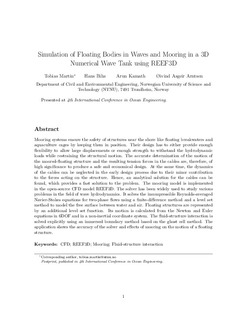| dc.contributor.author | Martin, Tobias | |
| dc.contributor.author | Kamath, Arun | |
| dc.contributor.author | Bihs, Hans | |
| dc.date.accessioned | 2019-03-20T12:34:16Z | |
| dc.date.available | 2019-03-20T12:34:16Z | |
| dc.date.created | 2018-11-02T14:45:57Z | |
| dc.date.issued | 2019 | |
| dc.identifier.isbn | 978-981-13-3118-3 | |
| dc.identifier.uri | http://hdl.handle.net/11250/2590846 | |
| dc.description.abstract | Mooring systems ensure the safety of structures near the shore like floating breakwaters and aquaculture cages by keeping them in position. Their design has to either provide enough flexibility to allow large displacements or enough strength to withstand the hydrodynamic loads while restraining the structural motion. The accurate determination of the motion of the moored-floating structure and the resulting tension forces in the cables is, therefore, of high significance to produce a safe and economical design. At the same time, the dynamics of the cables can be neglected in the early design process due to their minor contribution to the forces acting on the structure. Hence, an analytical solution for the cables can be found, which provides a fast solution to the problem. The mooring model is implemented in the open-source CFD model REEF3D. The solver has been widely used to study various problems in the field of wave hydrodynamics. It solves the incompressible Reynolds-averaged Navier–Stokes equations for two-phase flows using a finite-difference method and a level set method to model the free surface between water and air. Floating structures are represented by an additional level set function. Its motion is calculated from the Newton and Euler equations in 6DOF and in a non-inertial coordinate system. The fluid–structure interaction is solved explicitly using an immersed boundary method based on the ghost cell method. The application shows the accuracy of the solver and effects of mooring on the motion of a floating structure. | nb_NO |
| dc.language.iso | eng | nb_NO |
| dc.publisher | Springer Verlag | nb_NO |
| dc.relation.ispartof | Proceedings of the Fourth International Conference in Ocean Engineering (ICOE2018) | |
| dc.title | Simulation of Floating Bodies in Waves and Mooring in a 3D Numerical Wave Tank using REEF3D | nb_NO |
| dc.type | Chapter | nb_NO |
| dc.description.version | acceptedVersion | nb_NO |
| dc.source.pagenumber | 673-683 | nb_NO |
| dc.identifier.doi | 10.1007/978-981-13-3119-0_44 | |
| dc.identifier.cristin | 1626459 | |
| dc.relation.project | Norges forskningsråd: 267981 | nb_NO |
| dc.description.localcode | This is a post-peer-review, pre-copyedit version of an article published in [Lecture Notes in Civil Engineering ] Locked until 17.1.2020 due to copyright restrictions. The final authenticated version is available online at: https://doi.org/10.1007/978-981-13-3119-0_44 | nb_NO |
| cristin.unitcode | 194,64,91,0 | |
| cristin.unitname | Institutt for bygg- og miljøteknikk | |
| cristin.ispublished | false | |
| cristin.fulltext | postprint | |
| cristin.fulltext | original | |
| cristin.qualitycode | 1 | |
